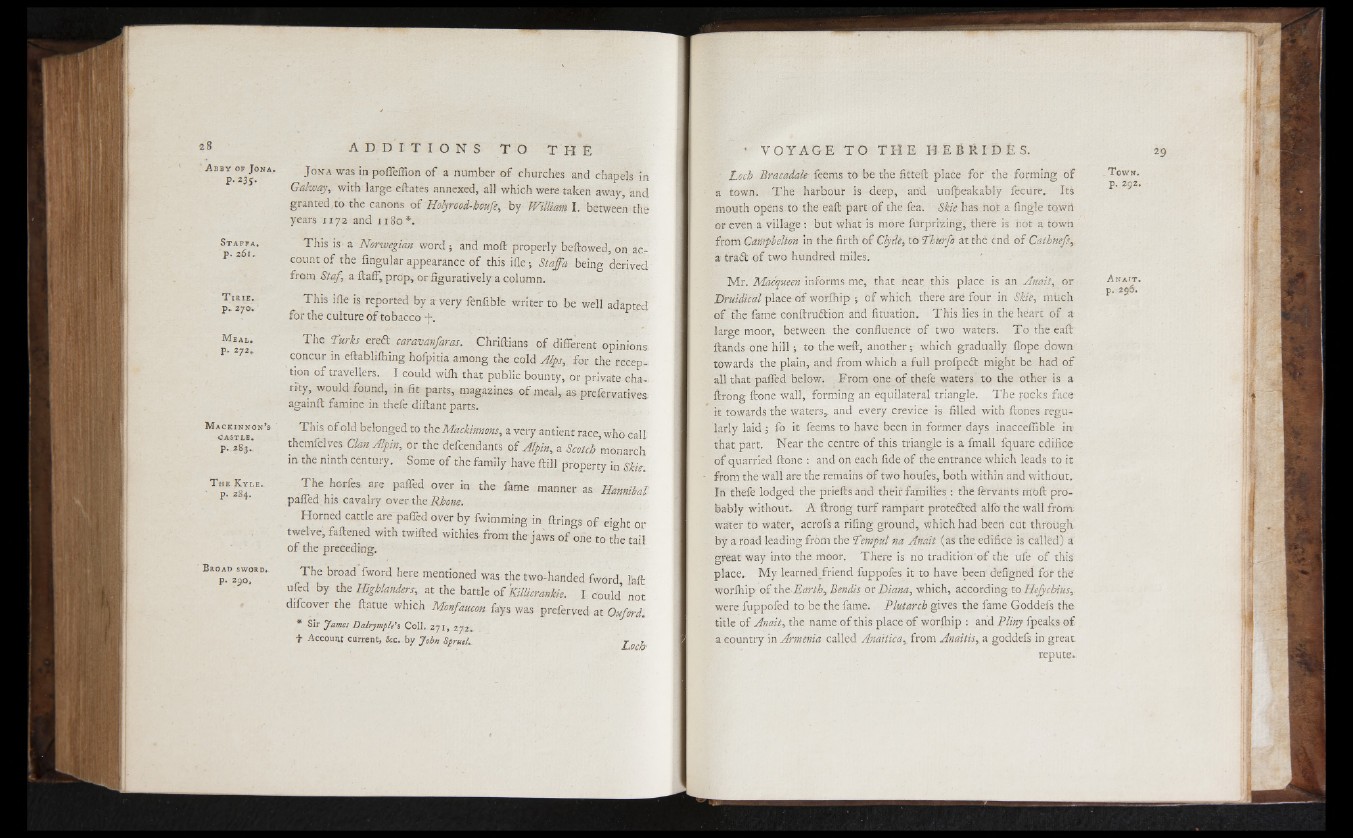
p. 235*
A b b y o f Jo ita»
S t a f f a .
p . 261»
T [ R I E .
p.. 270.
M e a l .
p . 272.
M a c k i n n o n ’s
c a s t l e .
P* 283.,
T h e K y l e . -
p. 2S4.
Br o a d sword«.
p. 290,
J on a was inpofleffion o f a number o f churches and chapels in
Galway, with large eftates annexed, all which were taken away, and
granted,to the canons o f Ilolyrood-houfe, by William I. between the
years 1 1 7 2 and 1 18 0 * .
This is' a Norwegian word; and mod properly bellowed, on account
of the fingular appearance of this ifle; Staffa being derived
from Staf, a Haff, prop, or figuratively a column.
This ilk is reported by a very lenfible writer to be well adapted
for the culture of tobacco J-.
The Turks ereft caravanfaras. Chriftians of different opinions,
concur in eftablilhing hofpitia among the cold Alps, for the reception
of travellers. I could wilh that public bounty, or private charity,
would found, in fit parts, magazines of meal, as prefervatives
againft famine in thefe diftant parts.
This o f old belonged to t\\cMackinnons, a very antient race, who call
themfelves Clan Alpin, or the defendants of Alpin, a Scotch monarch
in the ninth century. Some of the family have Hill property in Skie.
The horfes are patted over in the fame manner as Hannibal
paded his cavalry over the Rhone.
Horned cattle are palfed over by fwimming in firings of eight or
twelve, fattened with twilled withies from the jaws of one to the tail
of the preceding.
The broad fword here mentioned was the two-handed fword fell
ufed by the Highlanders, at the battle of Killicrankie. I could not
difcover the ftatue which Monfaucon fays was preferved at Oxford.
* Sir fames Dalrymple's C o ll. 2 7 1 , 272.
+ Account current, Sec. by John Sprue!.. Loch
■ Loch Bracadale■ feems to be the fitteli place for the forming of
a town. The harbour is deep, arid unfpéakably fecure.. Its
mouth opens to the eaft part of the fea. Skie has hot a fingle towri
or even a village : but what is more furprizing, there is not a town
from Campbelton in the firth of Clydej to Lhnrfo at thé end of Cathnefs
a traci of two hundred miles;
Mr. Macqueen informs me, that near this place is an Anv.it, or
Lruidical place of worlhip ; of which there are four in Skie, much
of the fame conftruftion and fituation. This lies in the heart of a
large moor, between the confluence of two waters. Totheeaflr
Hands one hill ; to the weft, another ; which gradually Hope down
towards the plain, and from which a full profpeit might be had of
all that palfed below. From one of thefe waters to the other is a
ftrong Hone wall, forming an equilateral triangle. The rocks face
k towards the waters, and every crevice is filled with Hones regularly
laid ; fo it feems to have been in former days inacceflible in
that part. Near the centre of this triangle is a fmall fquare edifice
of quarried Hone : and on each fide of the entrance which leads to it
from the wall are the remains of two houfes, both within and without..
In thefe lodged the priefts and theirfamilies : the férvants moll probably
without- A ftrong turf rampart protefted alfo the wall from
water to water, acrofs a riling ground, which had been cut through
by a road leading from the fenipul na Ànait (às the edifice is called) a
great way into the moor. There is no tradition'of thè ufe of this
place.. My learned friend fuppofes it to have been defigned for the
worfhip of the-Earth, Bendis ox Liana, which, according to Hefychius,.
were fuppofed to be the fame. Plutarch gives the fame Goddefs the
title of Anait, the name of this place of worlhip : and Pliny fpeaks of
a country in Armenia called Amitica, from Anaitis, a goddefs in great
repute.
T o w n .
p. 292.
A n a i t .
p. 296.